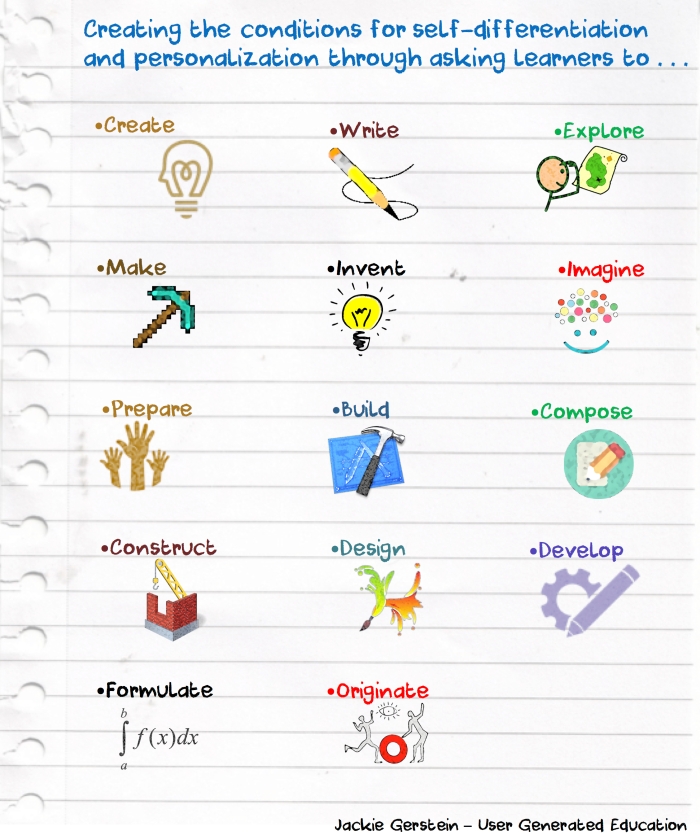Natural Differentiation and Personalization Through Open Ended Learning Activities
This past summer I facilitated maker education classes for 5 to 10 year old kids. This school year I am a gifted teacher meeting with 2nd through 6 grades one day per week per group. I like mixed age groups and have no problem designing learning activities for them. I realized that the reason for this is that these activities are open ended permitting each student to naturally and instinctively to work at or slightly above his or her ability level. This actually is a definition of differentiation.
Many classrooms consist of students from different knowledge backgrounds, multiple cultures, both genders, and students with a range of disabilities or exceptionalities (Alavinia & Fardy, 2012). Differentiated instruction is defined as “a philosophy of teaching that is based on the premise that students learn best when their teachers accommodate the differences in their readiness levels, interest, and learning profiles” (Konstantinou-Katzi et al., 2012, p. 333). (in http://edutechwiki.unige.ch/en/Differentiated_learning)
One of results or consequences of providing such activities is an increase in learner engagement, excitement, and motivation. Open ended learning activities permit and encourage learners to bring their “selves” into the work. They become agents of their own learning.
Because of this freedom, they often shine as true selves come through. Learners often surprise both the educator and themselves with what they produce and create. It becomes passion-based learning. Not only do the activities become self-differentiated, they become personalized:
Personalization only comes when students have authentic choice over how to tackle a problem. A personalized environment gives students the freedom to follow a meaningful line of inquiry, while building the skills to connect, synthesize and analyze information into original productions. Diane Laufenberg in What Do We Really Mean When We Say ‘Personalized Learning’?
Personalized learning means that learning starts with the learner. Learning is tailored to the individual needs of each learner instead of by age or grade level. It is more than teaching to “one size fits all” or just moving to learner-centered learning and changing instruction. Personalized Learning takes a holistic view of the individual, skill levels, interests, strengths and challenges, and prior knowledge. The learner owns their learning. Barbara Bray in What is Personalized Learning?
The educator, in this environment, introduces the activities and then steps back to let the learners take over their own personal learning. The educator lets go of expectations what the final produce should be; should look like; should do. The educator becomes a provider of resources, feedback giver, and communications facilitator. S/he becomes a tour guide of learning possibilities. S/he shows learners the possibilities and then gets out of the way.
Creating the conditions for self-differentiation and personalization can occur with learning objectives that start with action verbs such: create, write, explore, invent, make, imagine, prepare, build, compose, construct, design, develop, formulate, originate.

Parting Shot: The following is an Animoto I created to show how many forms of making there are, but it also demonstrates what can happen when open ended projects are introduced into the learning environment.

I really enjoyed your animoto, Jackie. All participants looked to have enjoyed themselves and to be proud of their work. I love your infographic about differentiation and personalisation. Well done. Thanks for sharing.
Norah
September 12, 2016 at 10:30 am
Thanks, Nora
Jackie Gerstein, Ed.D.
September 12, 2016 at 12:14 pm
I’m just getting back into open ended activities (I did them in my undergrad because I had a MASTER teacher who was sooooo good at it… and then I felt totally overwhelmed when in a classroom by myself) and the info graphic actually is helping me frame how I want to tackle this new phase in my classroom. We generated ideas on what we want to become engaged in and now we just have to… do it.
Katie
September 24, 2016 at 3:42 am